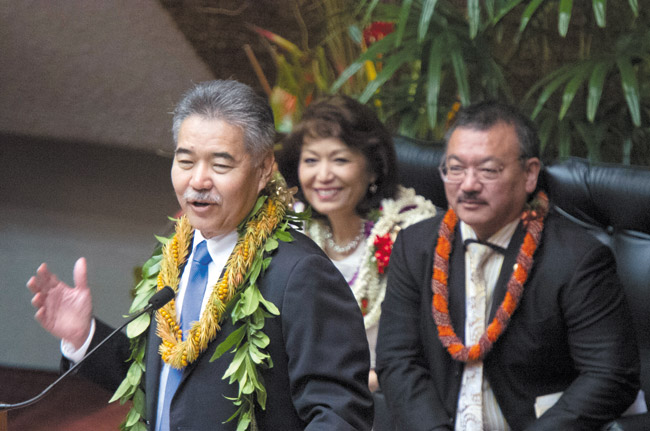Stating What’s Been Stated Before
A couple of Mondays ago, legislators milled about the floor of the House of Representatives, awaiting the call to order and the arrival of Gov. David Ige to deliver his first State of the State address. They laughed, exchanged pleasantries and glanced up at the gallery.
They were, almost to a man, dressed in high sartorial drab, from what must be Macy’s legislative suit collection. Suits there appear to come in only two colors: charcoal and off-charcoal. Serious colors those, almost as serious as those found in Macy’s funeral directors’ suit collection.
Even the couture of the wahines among this session’s lawmakers came in what could at best be described as muted tones.
Why? Have I missed something? Does the legislature have a dress code that mandates the solemnity of charcoal?
Style aside, the gavel fell, an oli was chanted, the new governor introduced.
Ige’s metaphor of the morning was “home.” Said he: “Home brings everything into focus. We are building a home for our kupuna, for our children and for ourselves.
“A home must have a solid foundation,” said the former Senate Ways and Means Committee chair. “That starts with solid financing.
“I recently submitted a preliminary budget that maintains state programs at current spending levels based on two sobering realities: First, we have duly committed our current funds to existing programs and services, and second, we are spending more than we take in.”
So how to increase revenue? Send someone to Washington to find the $940 million federal officials tell Ige is “available to the state for the right projects, proposed for the right reasons at the right time.” Three big “rights,” those. Oh, and “do a better job of collecting taxes.”
Ige also preached salvation through rail: by using state land parcels along its route for affordable homes, rental housing, a veterans’ care facility and whatever defense installations can be built near it, thus attracting federal dollars and creating jobs, housing and rail riders.
“And let me make one thing clear,” said Ige. “This governor wants rail to succeed and I’m committed to it. But let’s also make sure we do things the right way for the right reasons, including cost containment, before we ask for any more money.”
Read, “So sorry, Mayor Caldwell.”
Ige acknowledged the need to strengthen the state’s public hospitals. But he offered nothing save a weak mention of the potential of those old, all-purpose “public-private partnerships” as a means to do so.
On education, Ige took a swipe at the Department of Education: “I challenge the leaders of public education to stop issuing mandates from the state office and to focus on empowering schools and delivering resources to the school level.”
Seven politicians have preceded Ige in the Governor’s office. Two, William Quinn and Jack Burns, are dead, and one, Linda Lingle, has gone to Illinois. But four sat to Ige’s right as the new governor spoke: Neil Abercrombie, John Waihee, Ben Cayetano and George Ariyoshi.
They must have thought, perhaps in mental unison, “Boy! I’ve heard all this before. Hell! I said it all before.”
He, or they, undoubtedly did, in their combined 34 State of the States. And those of us who’ve lived long enough have certainly heard most, if not all, of what Ige said last week — most, if not all, repeatedly.
The challenges to a small island state with a limited economic base don’t change much over the years.
They’re as daily and drab as a charcoal suit.
dbboylan70@gmail.com






